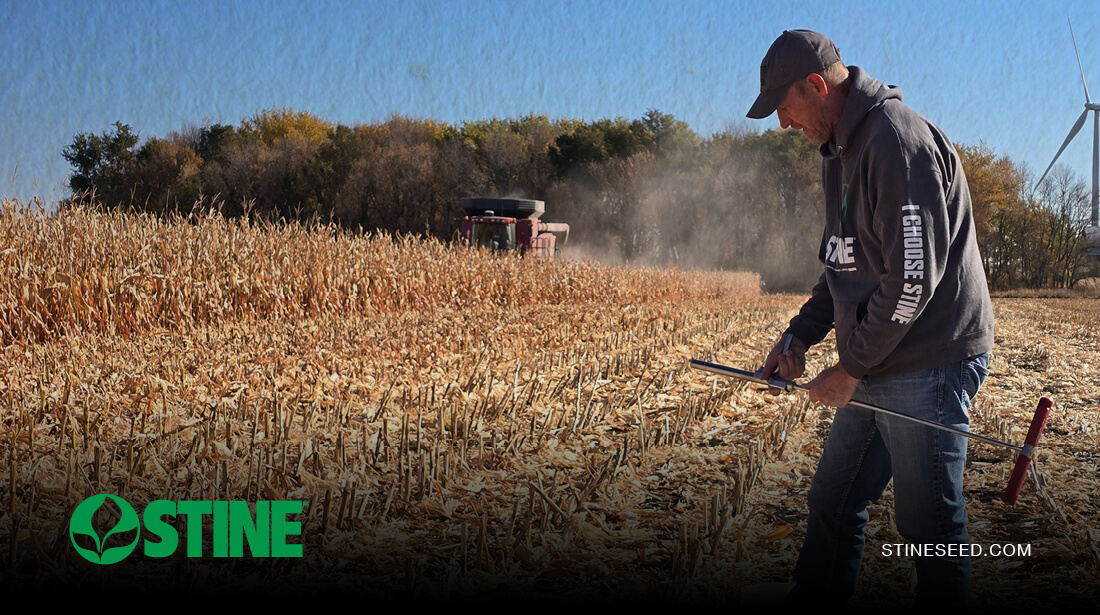As harvest season winds down, farmers deserve a well-earned break. However, fall is also the perfect time to start preparing your soil to ensure a successful planting season next year.

“Soil fertility takes careful planning, testing and management,” says Tony Lenz, Stine® Seed Company technical agronomist. “If the conditions are right and it's not too dry, fall is a great time to dig into the dirt postharvest, get soil samples and create a strategy to replace what this year’s crop took from the ground."
Here are some soil sampling and fertility planning tips to set your fields up for success.
Why fall is ideal for soil sampling
Soil sampling is a crucial step in understanding the nutrient makeup of your fields, helping you fine-tune fertility plans for the upcoming year. While spring may seem like the obvious time to sample, fall offers several advantages, including more consistent results due to stable soil conditions, as highlighted by the Agronomic Crops Network at Ohio State University Extension.
- Stable soil conditions: Fall soil is less affected by recent planting activities, leading to more consistent results. That said, it's important to proceed with caution if your soil is dry.
- More time for adjustments: Fall soil testing provides farmers the opportunity to make amendments before the next planting season begins, reducing time constraints in spring.
- Nutrient leaching: Winter snowmelt can lead to leaching, and knowing your soil's nutrient levels ahead of time helps you prepare to replace what may be lost.
Creating a fertility plan based on your results
Once you’ve collected soil samples, work with a local agronomist or extension specialist to interpret the results and develop a fertility plan. Knowing your soil’s levels of nitrogen, phosphorus, potassium and other micronutrients allows you to apply only what’s needed, preventing overapplication and reducing input costs. Purdue University Extension provides a useful guide on interpreting soil test results to help maximize the value of your tests. Here’s a simple approach to fertility planning:
- Review soil test results: Analyze the results holistically. Pinpoint any deficiencies or excesses in nutrients and consider how each nutrient works in tandem with others to optimize performance.
- Plan applications for fall or spring: While nitrogen is often applied in spring, many other inputs, like lime or phosphorus, can be added in the fall for better integration.
- Don’t skip sulfur: Sulfur is essential to metabolizing nitrogen and is an often-overlooked nutrient. Like nitrogen, it’s best to apply sulfur early in the season, so knowing where these two nutrients stand before next planting season is critical to your crop’s success.
- Consider cover crops: Cover crops, like winter rye or clover, help protect the soil during winter and contribute to organic matter for next season's crops. According to the U.S. Department of Agriculture National Resources Conservation Service, cover crops are key to improving long-term soil health.
When is the best time to sample?
The best time for soil sampling is right after harvest when the soil is stable and unplanted. Iowa State University Extension and Outreach suggests fall sampling, as it allows farmers to make timely nutrient management decisions for spring planting. If you delay until spring, nutrient imbalances may affect planting, which can lead to reduced yields.
Lenz recommends growers take samples in fields that underperformed this year. “Take note of areas that didn’t yield as well and map out a plan for soil sampling so you can see where your nutrient levels are for that particular spot,” he adds.
Experts from Iowa State University also recommend waiting until moisture levels are appropriate before testing the soil.
"Fall 2024 has been exceptionally dry. In extremely dry conditions soil test results appear lower than they actually are. Delay soil sampling in extremely dry conditions, until rainfall has soaked the depth of sampling, usually 6 inches," notes Gentry Sorenson, field agronomist in Northwest Iowa for Iowa State University Extension.
For additional guidance on proper sampling techniques, consult your local university extension specialist or review their online resources for soil testing. We also provide some great tips in this blog article.
Staying ahead of the game with a fertility management program
A comprehensive fertility management program is essential to maintain soil health year after year. A tailored program includes important items like soil type, crop history and test results to help you make the best decisions for your operation.
Stine agronomists are available to help you ensure your soil is in the best possible condition to support high yields. If you’re unsure where to start, our expert team can guide you through the process.
Don’t wait for spring: Fall is the time to act
Preparing your soil in the fall takes some extra effort, but the benefits are clear. By staying proactive and using soil sampling as a foundation for fertility management, you’re setting yourself up for a more productive growing season next year.
For more information on soil health and fertility programs, reach out to your local Stine sales representative or one of our agronomists.
Related Articles
-

Stine® to offer Syngenta’s Victrato® soybean seed treatment in 2026
December 2025 in Agronomy
-

Use Stine’s XP® seed treatments to prevent early injury to your crops
December 2025 in Agronomy
-

Understanding Stine’s enhanced oil profile soybeans
December 2025 in Agronomy
-

Soil sampling sets the stage for spring
November 2025 in Agronomy



